
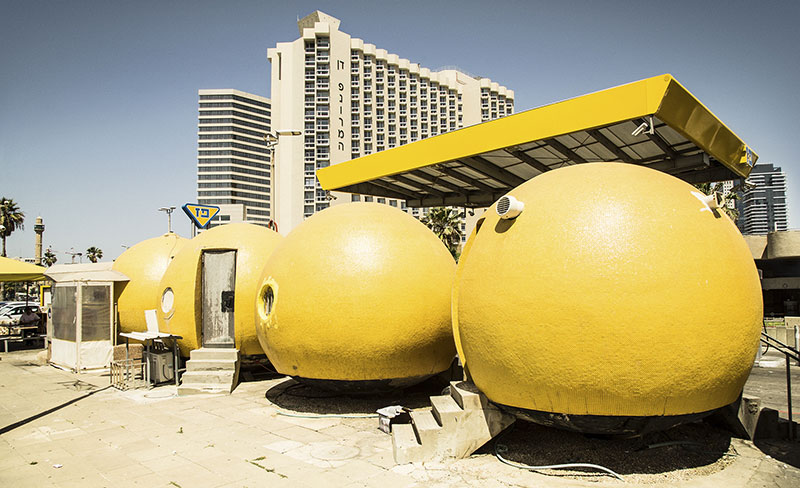
Israel Through the Eyes Of Photographer Daniel Woeller
Daniel Woeller
Germany
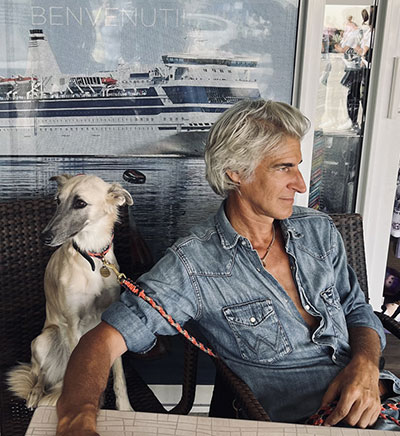
Me, Daniel Woeller, with my double, the long-haired whippet lady Pepper.
For me, Israel represents not only a search for traces of my own roots, but also an inspiration and ingredient in my work as a photographer and artist. I follow tracks and let myself drift.
My father, born in 1934 as the eldest of three children, survived the Second World War and the Nazi regime as a ”half-Jew,” or person of “mixed race,” with his siblings and single mother. His Jewish father, my grandfather, was able to flee to Switzerland and left his non-Jewish wife and their children to their fate in Frankfurt. How my grandmother managed to survive with her children is and remains a secret. It wasn't discussed and my questions went unanswered.
Like in so many families with similar stories, my dad's biography has a deep, black hole.
I was born and grew up in Frankfurt in 1966. I wasn't baptized.
My parents had many Jewish friends with whom we regularly met on vacation. Sometimes I saw numbers tattooed on the arms of the older ones. I was also fascinated by the Star of David, worn as a necklace by many men. I would have liked to wear one of these, but it made my father uncomfortable, though he never could or would explain why. I had many Jewish friends myself and visited them often at their homes, apartments or houses, and so I immersed myself deeper into a world that attracted me and to which I felt more and more curiously connected.

I arrived at the airport in Tel Aviv and immediately felt at home.

A friend convinced me that we should travel to Israel together and take in the country and its people. Maybe this would loosen knots? I once read that Tel Aviv is the most strenuous city in the world. I don't agree with that statement. For me, this lively and fascinating city is exactly the opposite, one of the least strenuous and effortless places in the world. I arrived at the airport in Tel Aviv and immediately felt at home. Getting started was easy: I was able to live with an old friend from Frankfurt, Naomi Bubis, and quickly connected with her circle of friends and acquaintances through several ex-Frankfurters who had emigrated to Tel Aviv. From the beginning, I never felt lost, lonely or foreign in Israel.
I like the heat, the sweat, and the sun gives me energy. The city pulsates, waves, vibrates and inspires me. Who needs sleep there?
I once read an article in which a German author wrote about the Hebrew word Lisrom, which signifies letting yourself be carried away by the current. For me, Lisrom aptly describes the unique mentality that is so noticeable in Israel and especially in Tel Aviv: an acceptance of the unpredictability of life and the primal belief that everything will somehow work out and be well. The only time I experienced a similar positive serenity was in Naples, under the constant threat of the volcano Vesuvius and the invisible presence of the Camorra.
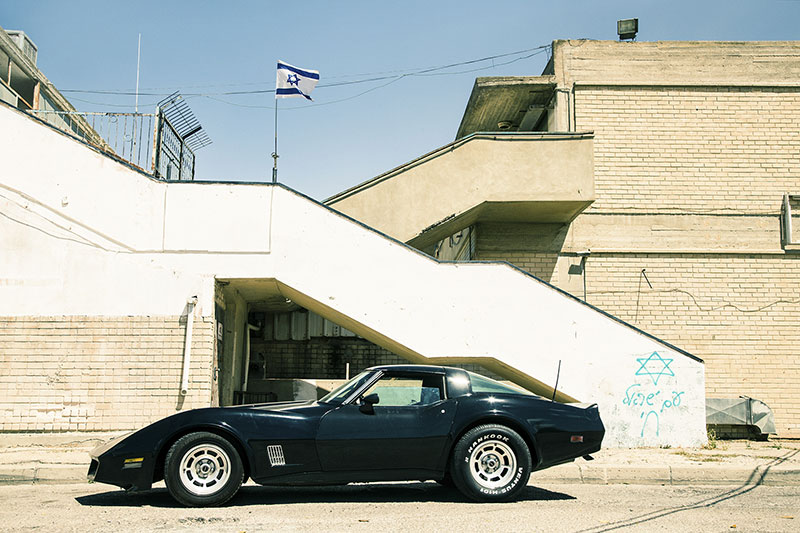
ARAD BLACK CORVETTE "AM YISRAEL CHAI!" - black Chevrolet Corvette in front of a graphic architectural staircase, Arad, Israel.
The Israelis are a unique mix of peoples from a wide variety of countries of origin, whose millennia-old history of persecution, flight and nomadism has shaped a cohesive DNA that is bursting with energy and the joy of life. They literally celebrate a daily “dance on the volcano.”
The country has been surrounded by enemies since its founding. It is regularly attacked by enemy missiles, which the Iron Dome defuses in the air. There are panic rooms in residential buildings, and when sirens sound at night, children are taken out of bed and people retreat to these shelters. Often, I would hear the detonations of the rockets/bombs being launched, and the next day there would be partying in the streets and dancing on cars.

People party all night long and philosophize in the bars and cafés.

Tel Aviv is incredibly fast and spontaneous. Innovative, creative and inventive.
Life in Tel Aviv is expensive, but you are used to spending money that is often tight and you learn to improvise. You live in the now, in the present — who thinks about tomorrow? The people are open, sociable, curious and helpful. They’re interested in your history and stories. Who are you? Where do you come from? Why are you visiting Israel? What ideas, visions or plans do you have?
Life takes place on the streets, in cafés, bars and restaurants. On the city’s beaches. People party all night long and philosophize in the bars and cafés. Many generations meet without prejudice, young soldiers—men and women— in uniform and carrying machine guns, half-naked joggers or cyclists, Shoah survivors, young and old, gay and straight, and, as if from another world, the Orthodox, in their black suits or traditional dress. I hardly know any place in the world that has such a tingling atmosphere, is so full of opposites.

The black suits and hats on some young people look very similar to the cool gangsters from Quentin Tarantino’s Reservoir Dogs.

As a photographer and artist, these strictly Orthodox people—often unloved among the non-Orthodox— have always made me curious. That's why I immersed myself in the Orthodox neighborhoods of Bnei Brak and Jerusalem to look for clues with my camera.
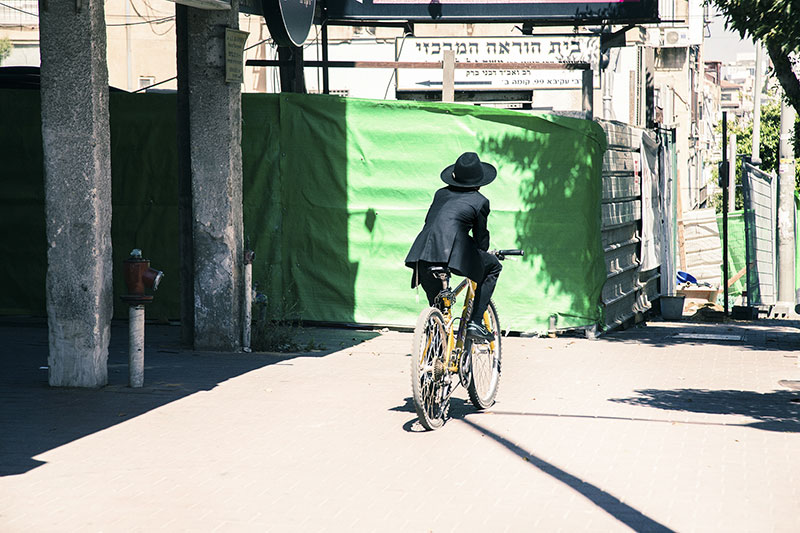
YOUNG GUN CRUISIN’ - cool orthodox boy shot in Bnei Brak
The black suits and hats on some young people look very similar to the cool gangsters from Quentin Tarantino's film Reservoir Dogs or to British rock stars like Pete Doherty. Other Orthodox people seem exactly the opposite: extremely nerdy and not of our world. The married women wear headscarves or wigs. The various traditional types of dress with the specific hats of the different movements — all of this is visually extremely inspiring for me. Just the right thing for my photography!
In order to immerse myself, I dressed inconspicuously in black clothing and a yarmulke, adjusted so that I could disappear into the whirlpool of people and take photos almost invisibly. During my last visit, I was particularly fascinated by Purim among the pious people, as it seemed to be an opportunity to break out of the expected role. I'm currently working on evaluating the photos for an exhibition project.
A short essay can only approximately describe the many facets of Israel and what makes me curious about it as an artist. In less than an hour you can get from Tel Aviv, a modern metropolis on the Mediterranean with its startups, skyline and great beach to Jerusalem, a historic old town full of religious symbolism and mysticism, narrow streets and thousands of years of history.
Camel caravans make their way along the roadside through the desert. In Arad, I spontaneously staged a black Chevrolet Corvette in front of a graphic architectural staircase, a great picture.
In Be’er Sheva, I accompanied the German conductor Justus Frantz as he rehearsed a symphony with The Israel Sinfonietta Be’er Sheva. I looked at the Dead Sea, with its dusty hotel ruins and shells of halted construction sites. Such morbid contemporary visuals have always interested me as photo locations.
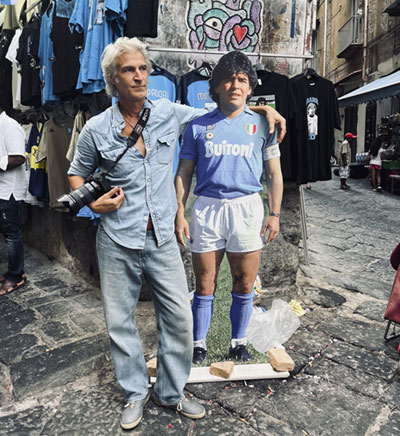
Daniel Woeller, arm in arm with the omnipresent holy D10S camera and Diego Maradona in Naples.
What I love about my work is location scouting. I studied architecture and like to stage my pictures in typical retro ambiences of the 1950s - 1980s that exemplify brutalism. I try to capture such special places in my photos before they finally disappear, and create an “archeology of urban history, architecture and design,” so to speak. Israel is rich in such stone monuments to architectural history— a history of modernity and departure, construction and decay, abandonment and restoration.
In any case, there is no shortage of topics there for me – and I will come back.
Contact Daniel Woeller at daniel@woellerphotography.com
Follow on Instagram @woellersworld
